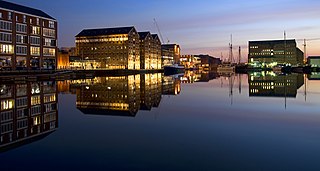
Gloucester is a cathedral city and the county town of Gloucestershire in the South West of England. Gloucester lies on the River Severn, between the Cotswolds to the east and the Forest of Dean to the west; it is sited 19 miles (31 km) east of Monmouth and 17 miles (27 km) east of the border with Wales. Gloucester has a population of around 132,000, including suburban areas. It is a port, linked via the Gloucester and Sharpness Canal to the Severn Estuary.

Blossom Park is a neighbourhood in Gloucester-Southgate Ward in the south-end of the city of Ottawa, Ontario, Canada. Before the 2001 city of Ottawa amalgamation it was a suburb of the city of Gloucester. The current limits of the neighbourhood are: Hunt Club Road to the north, Airport Parkway to the west, Conroy Road to the east and the Greenbelt to the south.

Lloyds Bank plc is a British retail and commercial bank with branches across England and Wales. It has traditionally been considered one of the "Big Four" clearing banks. Lloyds Bank is the largest retail bank in Britain, and has an extensive network of branches and ATMs in England and Wales and offers 24-hour telephone and online banking services.

Brockworth is a village and parish in the Borough of Tewkesbury, Gloucestershire, England, situated on the old Roman road that connects the City of Gloucester with Barnwood. It is located 4 miles (6.4 km) southeast of central Gloucester, 6 miles (9.7 km) southwest of Cheltenham and 11.5 miles (18.5 km) north of Stroud. The population taken at the 2011 census was 7,387. The population increased to 9,422 at the 2021 Census.
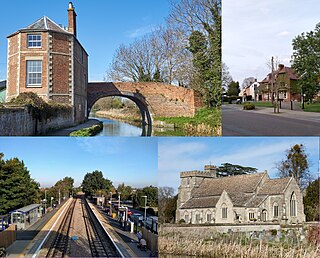
Stonehouse is a town in the Stroud District of Gloucestershire in southwestern England.

Gloucester is a constituency centred on the cathedral city and county town of the same name, represented in the House of Commons of the UK Parliament by Richard Graham of the Conservative Party.

Hardwicke is a large village on the A38 road 7 km south of the city of Gloucester, Gloucestershire, England. Despite its proximity to Gloucester, the village comes under Stroud Council. The population of the village taken at the United Kingdom Census 2011 was 3,901.

Quedgeley is a town and civil parish in the city of Gloucester in Gloucestershire, England. A thin strip of land between the Severn and the Gloucester Ship Canal occupies the west, and the south-eastern part of the town is Kingsway Village, directly to the north of which is Tuffley.

Arlingham is a village and civil parish in the Stroud District of Gloucestershire, England. The 2021 Census recorded a parish population of 533. The parish contains the hamlets of Milton End, Overton and Priding. The next parish to the east is Fretherne with Saul.

Hill Samuel is a wholly owned subsidiary of Lloyds Banking Group's Offshore Private Banking unit. It was formerly a leading British merchant bank and financial services firm before the takeover by TSB Group Plc. in 1987, which itself merged with Lloyds Bank to become Lloyds TSB in 1995.

Down Hatherley is a civil parish and village in the Tewkesbury Borough, between Cheltenham and Gloucester, Gloucestershire. It has approximately 165 houses and a population of 450, reducing to 419 at the 2011 census. The village is situated approximately 3.5 miles (5.6 km) northeast of Gloucester city centre.
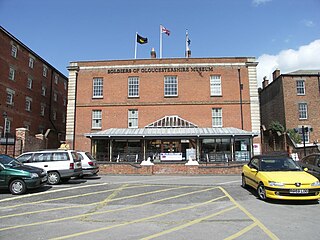
The Soldiers of Gloucestershire Museum is located within the historic docks in the city of Gloucester. The museum tells the story of two regiments of the British Army, the Gloucestershire Regiment, including its antecedents the 28th Regiment of Foot and the 61st Regiment of Foot, and the Royal Gloucestershire Hussars, both of which recruited heavily from Gloucestershire and Bristol.

Sir Matthew Wood, 1st Baronet was a British Whig politician, Lord Mayor of London from 1815 to 1817, and from 1817 until his death in 1843 a reformist Member of Parliament.

Cheltenham & Gloucester plc (C&G) was a mortgage and savings provider in the United Kingdom, a subsidiary of Lloyds Banking Group. C&G specialised in mortgages and savings products. Previously, C&G was a building society, the Cheltenham and Gloucester Building Society. Its headquarters were in Barnwood, Gloucester, Gloucestershire, England. C&G was closed to new mortgage and savings business on 9 September 2013.
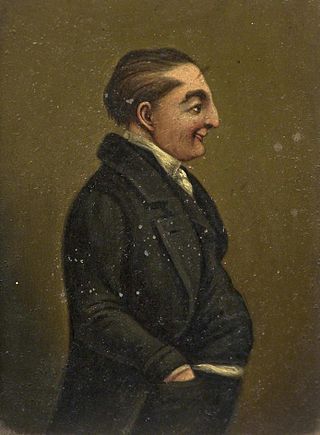
James "Jemmy" Wood was the owner of the Gloucester Old Bank who became nationally known as "The Gloucester Miser". His wealth of around £900,000 was stated at the time to have made him "the richest commoner in His Majesty's dominions".

The Westgate area of Gloucester is centred on Westgate Street, one of the four main streets of Gloucester and one of the oldest parts of the city. The population of the Westgate ward in Gloucester was 6,687 at the time of the 2011 Census.

The Old Wye Bridge or Town Bridge at Chepstow, also known historically as Chepstow Bridge, crosses the River Wye between Monmouthshire in Wales and Gloucestershire in England, close to Chepstow Castle. Although there had been earlier wooden bridges on the site since Norman times, the current road bridge was constructed of cast iron in 1816 during the Regency period, by John Rastrick of Bridgnorth, who greatly modified earlier plans by John Rennie.
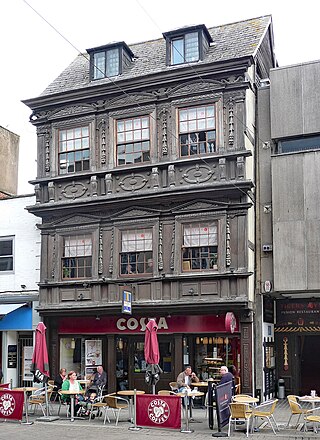
9 and 9A Southgate Street is a 17th-century Jacobean timber-framed merchant's house on Southgate Street, Gloucester. It has been a Grade I listed building since 23 January 1952. 9 Southgate Street is now occupied by Costa Coffee and 9A Southgate Street is occupied by The Tiger's Eye restaurant.

George Worrall Counsel was a Gloucester solicitor, antiquarian, alderman, and property developer.
Eastgate Street is one of the ancient streets in Gloucester, so named because its eastern end was originally the location of the east gate in the city's walls. The part beyond the gate as far as GL1 leisure Centre was part of Barton Street It runs from the crossroads of Northgate, Eastgate, Southgate and Westgate Streets in the West to Barton Street in the East.






















